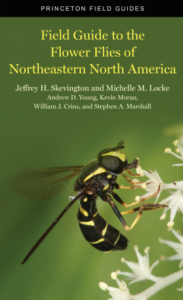 The first time I saw a flower fly, I natural thought it was a bee.
The first time I saw a flower fly, I natural thought it was a bee.
The second time I saw one, I also thought it was a bee.
Third time – “OK, that has to be a bee.”
Fourth time – “Definitely a bee.”
After about twenty or so, I finally got one right on the first try.
I take comfort in the fact that rather than me being unusually thick (which is usually the explanation…) my misidentification of these remarkable little syrphid flies (being members of the family Syrphidae, and often commonly called hoverflies as well as flower flies) was due to their remarkable skills in mimicking the appearance and behaviors of bees and wasps. Telling them apart from these hymenopterans is tricky enough; telling them apart from one another is another matter entirely.
That’s where the new Field Guide to the Flower Flies of Northeastern North America from Princeton University Press comes in. Written by Jeffrey H. Skevington and Michelle M. Locke, with Andrew D. Young, Kevin Moran, William J. Crins and Stephen A. Marshall, this first-of-its-kind guide covers all 416 flower fly species occurring north of Tennessee and east of the Dakotas, including the high Arctic and Greenland. However for all those outside of that North American region, fear not, as the range maps encompass the the entirety of North America so all the species profiled in this guide are shown in their full continental range.
If you enjoyed reading this, please consider signing up for The Well-read Naturalist's newsletter. You'll receive a helpful list of recently published reviews, short essays, and notes about books in your e-mail inbox once each fortnight.
